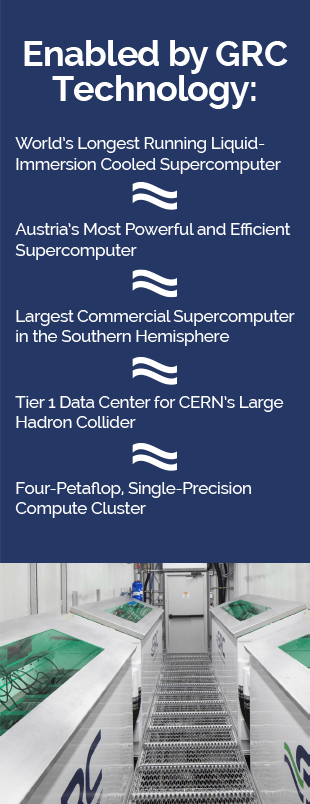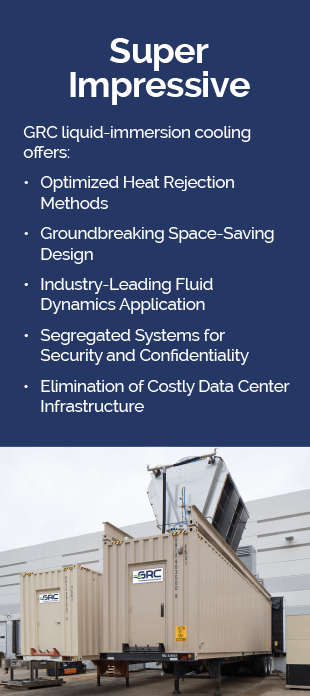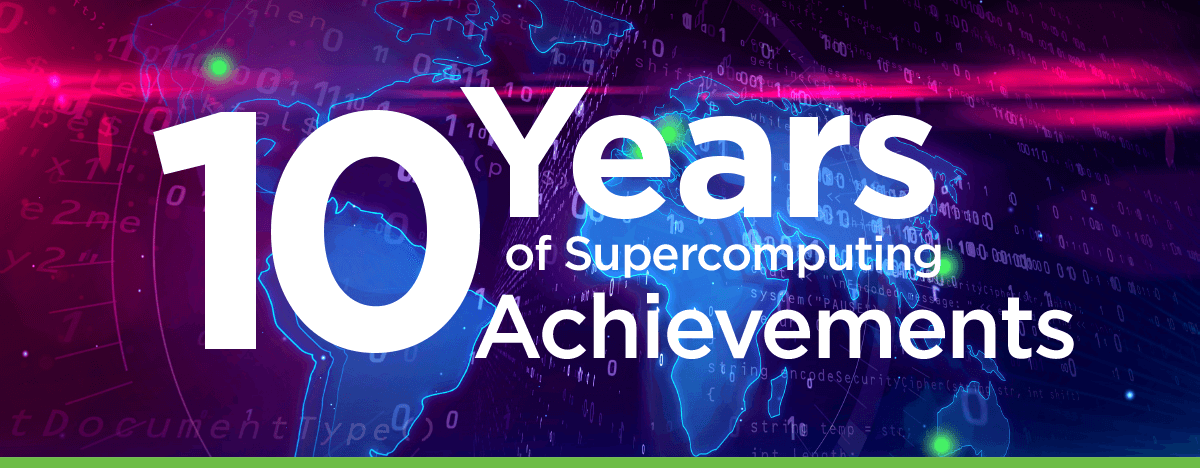Since 2009, GRC has been the pioneer and the world’s leader of single-phase liquid-immersion cooling. Over these last 10 years we’ve helped some of the most powerful supercomputing entities on Earth attain incredible milestones and earn well-deserved accolades. Today, GRC customers have ranked in the TOP500 supercomputer listing and in the Green500, including back-to-back wins by the Tokyo Institute of Technology.
It’s About More Than Awards
More than mere accolades, these supercomputing achievements have helped organizations break through barriers, attain huge savings in
construction and energy costs, as well as realize tremendous gains in efficiency and reliability.
Our Timeline of Six Key Liquid-Immersion Supercomputer Cooling Achievements:

Texas Advanced Computing Center (TACC)
Located at the University of Texas at Austin, TACC operates some of the most powerful computing resources on the planet. But its other claim to fame is that it is home to the world’s longest running liquid-immersion cooling system.
TACC first partnered with GRC in 2009 to explore the benefits of immersion cooling and validate its energy & cost savings potential. Beginning with a single unit located on their loading dock, they started realizing Texas-sized benefits right away: significantly better heat transference plus far lower operating costs. In fact, TACC found that it only took about 300 watts to cool 10 kilowatts of power. But that was just the start of their affinity for liquid-immersion cooling. Over the years they’ve increased the number of GRC systems on-hand, using them to support their mission and cool formidable supercomputing engines, such as the Maverick2 deep learning machine.
Keep reading to see how they’ll be continuing their immersion-cooling journey to build a truly world-class supercomputer – Frontera.

Tokyo Institute of Technology Supercomputer: TSUBAME-KFC
After extensive testing with air-cooling strategies, Tokyo Tech soon came to a harsh realization. Only single-phase liquid immersion cooling would tame their TSUBAME-KFC computer for the high-performance operations they routinely run.
Our ICEraQ™ liquid-immersion cooling system was up to the task – with benefits to spare. For one, ICEraQ delivered an incredibly low PUE of 1.02. As a result, in 2013 the Green500 ranked the TSUBAME-KFC number one in the world in power efficiency, with a 24% lead over the secondranked machine. This stood as a 40% improvement over the previous Green500 record. Not surprisingly, 2014 brought Tokyo Tech their second Green500 #1 ranking using GRC liquidimmersion cooling solutions.

Vienna Scientific Cluster (VSC) Supercomputer: VSC-3
VSC had a vision. They sought to build a third generation of Austria’s most powerful and efficient supercomputer. Partnering with Intel®, Supermicro® and ClusterVision, GRC brought that vision to light, delivering a cluster optimized for cost, performance and density.
Installed in the only space VSC had available, a small 1,000-square-foot basement, our ICEraQ liquid-immersion cooling system attained an incredibly low mechanical PUE of 1.02. This was a 14% improvement over previous air-based systems, and helped them rank eighth on the Green500 supercomputer list.
VSC had estimated the cost of energy at about 35% of Total Cost of Ownership (TCO). Our solution exceeded this target in both upfront and ongoing operating costs. Plus, we helped them achieve it using zero water consumption. VSC’s supercomputing installation proves that green power and real power can be one in the same.
Case Study: Vienna Scientific Cluster’s The Immersion Supercomputer: Extreme Efficiency,
Needs No Water >>

DownUnder GeoSolutions (DUG) Supercomputer: Bruce
Located in Perth, Australia, DownUnder GeoSolutions (DUG) is an innovative geosciences company serving the global oil and gas industry. They also operate Bruce, the largest commercial supercomputer in the southern hemisphere running one of the world’s largest deployments of Intel® Xeon Phi™ co-processors.
Of course, Bruce’s eight petaflops of compute generates considerable heat. To help cool this massive amount of power in an eco-friendly way, GRC went above and beyond for DownUnder. Based on SGI servers, our liquid-immersion cooling solution reduced their cooling energy consumption by up to 90%. We’ve lowered their total energy cost by some 35%. And, as an added though foreseeable bonus, the system has also proven to be exceptionally reliable.

Port d’Informació Científica (PIC) Supercomputer: PIC’s Tier 1 Data Center for CERN’s Large Hadron Collider
PIC supports scientific groups working in projects requiring strong computing resources ?notably for particle physics, astronomy and cosmology. What’s more, their Barcelona, Spain location is a tier-1 data center for CERN’s Large Hadron Collider. The world’s largest, most powerful particle accelerator, the Collider requires a heavy kilowatt load to process petabytes of streaming data. PIC needed a cooling solution that would support this super-high load. But they had limited space. They also wanted to be environmentally conscious by conserving the excessive water usage associated with traditional air cooling.
PIC selected GRC to provide the solution. Our liquid-immersion cooling system met and exceeded all of PIC’s objectives. It eliminated water consumption through dry instead of traditional evaporative cooling. And we accomplished all this while reducing their power requirements a full 30%.
Installation Details >>

Texas Advanced Computing Center (TACC) Supercomputer: Frontera
To continue enabling discoveries that benefit science and society, longtime GRC customer, TACC, received a $60 million grant from the NSF to build Frontera, a single-precision compute cluster capable of running AI and machine learning applications. But, like other supercomputing initiatives, air cooling was not adequate to handle Frontera’s powerful GPU nodes. Liquid-to-chip technology was not suitable either.
TACC again called on GRC because of our proven successes since 2009.
To help them maximize GPU processing with the allotted grant monies, plus limit spending on infrastructure and other supporting hardware, GRC developed a comprehensive solution. Not only did we provide our ICEraQ micro-modular, racked-based cooling system. We also incorporated servers designed for immersion (SDI), and were able to tie into TACC’s existing infrastructure.
Slated to go live in late June of 2019, Frontera promises to break new barriers in supercomputing, just as GRC has shattered the limits of data center cooling.



Got an opinion? Let’s hear it
You don’t need to run a supercomputer to reap superb benefits through liquid-immersion cooling. So, contact us at info@grctesting.xyz or +1 (512) 692-8003 and see how we can help your data center be more efficient and cost-effective.
For more information on TOP500 or Green500 supercomputing visit TOP500.org.



